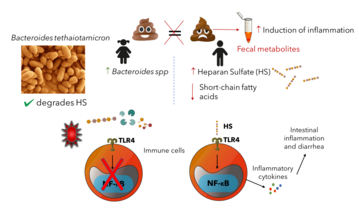Barbero R, Garriga M, Moreno A, Palacios E, Ruiz P, Vicente S, Stanescu S, Belanger A, Pintos G, Arconada B, Del Campo R, Avendaño J. The Role of the Gut Microbiota in Sanfilippo Syndrome's Physiopathology: An Approach in Two Affected Siblings
Int J Mol Sci . 2024
"Within the gut's microenvironment, the microbiota's metabolic activity could alleviate human enzymatic deficits playing a role in metabolic diseases pathophysiology" - Dr. José Avendaño and Raquel Barbero
Summary:
Sanfilippo syndrome, or mucopolysaccharidosis type III (MPS III), is a rare lysosomal disease caused by congenital enzymatic deficiencies in heparan sulfate (HS) degradation, leading to organ dysfunction. The most severe hallmark of MPS III comprises neurological alterations, although gastrointestinal symptoms (GISs) have also been shown to be relevant in many patients. Here, we explored the contribution of the gut microbiota to MPS III GISs. We analyzed the composition and functionality of the gut microbiota in two MPS III siblings with the same mutation (c.544C > T, c.1080delC, in the SGSH gene) and the same diet, but with differences in their GISs, including recurrent diarrhea in one of them. Using 16S sequencing, we observed that the MPS III patients exhibited decreased alpha diversity and a lower abundance of Lachnospiraceae and Bifidobacteriaceae accompanied by a higher abundance of the Ruminococcaceae and Rikenellaceae families than the healthy control subjects. Comparing siblings, we found an increased abundance of Bacteroidaceae and a lower abundance of Ruminococcaceae and Akkermansiaceae in the GIS-free patient. This patient also had a higher relative abundance of Sus genes (SusA, SusB, SusE, and SusG) involved in glycosaminoglycan metabolism. We found higher HS levels in the stool of the two MPS III patients than in healthy volunteers, particularly in the patient with GISs. Functionally, whole fecal metabolites from the patient with GISs induced oxidative stress in vitro in healthy monocytes. Finally, the Bacteroides thetaiotaomicron strain isolated from MPS III stool samples exhibited HS degradation ability. Overall, our results reveal different microbiota compositions and functionalities in MPS III siblings, who exhibited differential gastrointestinal symptomatology. Our study may serve as a gateway to explore the impact of the gut microbiota and its potential to enhance the quality of life in Sanfilippo syndrome patients.
Why do you highlight this publication?
Our stuy explores the contribution of the gut microbiota to GISs in Sanfilippo Syndrome, a rare metabolic disease leading to HS acumulation. Despite GISs being a relevant cause of disability in Sanfilippo Syndrome, there is no consensus on nutritional recommendations or probiotic supplementation. Our findings, including the isolation of a Bacteroides thetaiotaomicron strain capable of degrading HS in vitro, suggest that monitoring and potentially modulating the gut microbiota could offer new avenues for managing GISs and improving the quality of life for Sanfilippo Syndrome patients.
Publication commented by:
Dr. José Avendaño Ortiz and Raquel Barbero
Biology and Evolution of Microorganisms group
IRYCIS



